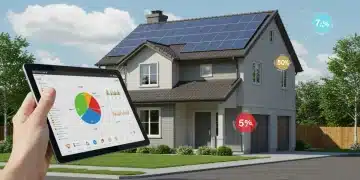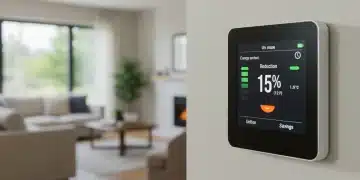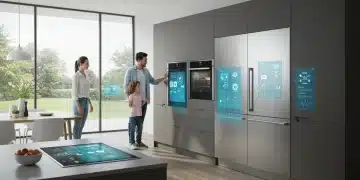Smart Home Sensors 2025: US Property Updates & Innovations
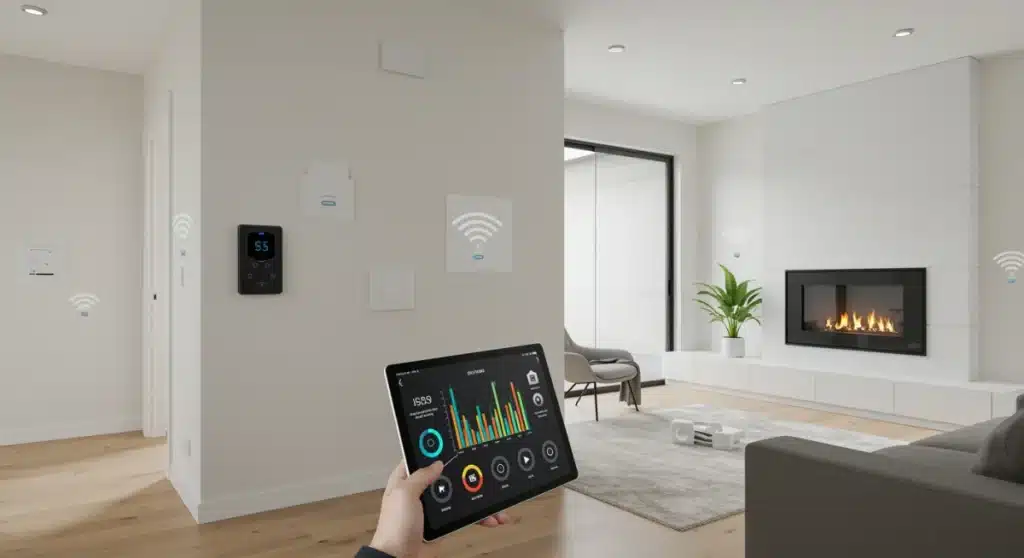
The Smart Home Sensors 2025 landscape is rapidly evolving, bringing unprecedented advancements to US properties. Homeowners are now seeing a surge in intelligent sensor technologies designed to enhance security, optimize energy use, and offer a truly personalized living experience.
The Rise of AI-Powered Predictive Sensors
As of early 2025, a significant shift is underway in smart home technology, with artificial intelligence (AI) becoming the backbone of next-generation sensors. These aren’t just reacting to events; they’re predicting them, offering a proactive approach to home management.
This new wave of AI integration allows sensors to learn household patterns, anticipate needs, and even detect potential issues before they escalate. It represents a fundamental change from simple automation to intelligent, adaptive environments.
Enhanced Anomaly Detection
One of the most impactful developments is in anomaly detection. AI-powered sensors can now differentiate between normal household activities and unusual occurrences with remarkable precision. This capability significantly boosts security and preventative maintenance.
- Unusual Activity Alerts: Sensors learn daily routines, flagging deviations such as unexpected door openings or prolonged periods of inactivity in specific areas.
- Predictive Maintenance: Monitoring HVAC systems or plumbing for subtle changes in performance that indicate impending failure, allowing for repairs before breakdowns occur.
- False Alarm Reduction: Sophisticated algorithms minimize false alarms from pets or environmental factors, improving the reliability of security systems.
Hyper-Personalization Through Contextual Awareness
Smart home sensors in 2025 are moving beyond basic automation to deliver truly hyper-personalized experiences. This is achieved through advanced contextual awareness, where sensors gather and interpret a wider array of data points to understand the environment and inhabitant preferences more deeply.
These systems integrate data from various sources, including ambient light, temperature, humidity, occupancy, and even individual biometric data (with consent), to create living spaces that adapt seamlessly to the user’s mood and activities.
Adaptive Environmental Control
The ability of sensors to understand context means climate control is no longer just about temperature. It now encompasses air quality, humidity, and even light spectrum, adapting to the time of day and the occupants’ specific needs.
- Dynamic Lighting: Adjusts brightness and color temperature based on natural light conditions, time of day, and user activity, promoting better sleep and productivity.
- Optimized Air Quality: Monitors pollutants, CO2 levels, and allergens, automatically triggering air purifiers or ventilation systems when thresholds are exceeded.
- Personalized Comfort Zones: Creates micro-climates within different rooms, catering to individual preferences without impacting the entire household.
Advanced Security and Access Control Innovations
Security remains a paramount concern for US property owners, and Smart Home Sensors 2025 are delivering groundbreaking solutions. We are seeing a convergence of biometric authentication, advanced motion detection, and integrated surveillance that offers unparalleled protection.
These systems are designed not only to deter intruders but also to provide comprehensive monitoring and immediate response capabilities, often leveraging edge computing for faster data processing and reduced latency.
Biometric Integration for Seamless Access
Fingerprint, facial, and even voice recognition are becoming standard features for smart locks and access points. This provides both high security and extreme convenience, eliminating the need for physical keys or complex codes.
- Multi-Factor Authentication: Combining biometric data with traditional methods like PINs or mobile verification for enhanced security layers.
- Temporary Access Management: Granting time-limited access to visitors or service providers through secure biometric profiles.
- Real-Time Identity Verification: Sensors can confirm the identity of individuals entering or leaving the property, logging all access events.
Energy Efficiency and Sustainability Driven by Sensors
With increasing awareness of environmental impact and rising energy costs, Smart Home Sensors 2025 are playing a crucial role in promoting energy efficiency and sustainability in US properties. These sensors provide granular data that allows for precise control over energy consumption, minimizing waste.
From smart thermostats that learn occupancy patterns to light sensors that prevent unnecessary illumination, the focus is on creating homes that are both eco-friendly and cost-effective.
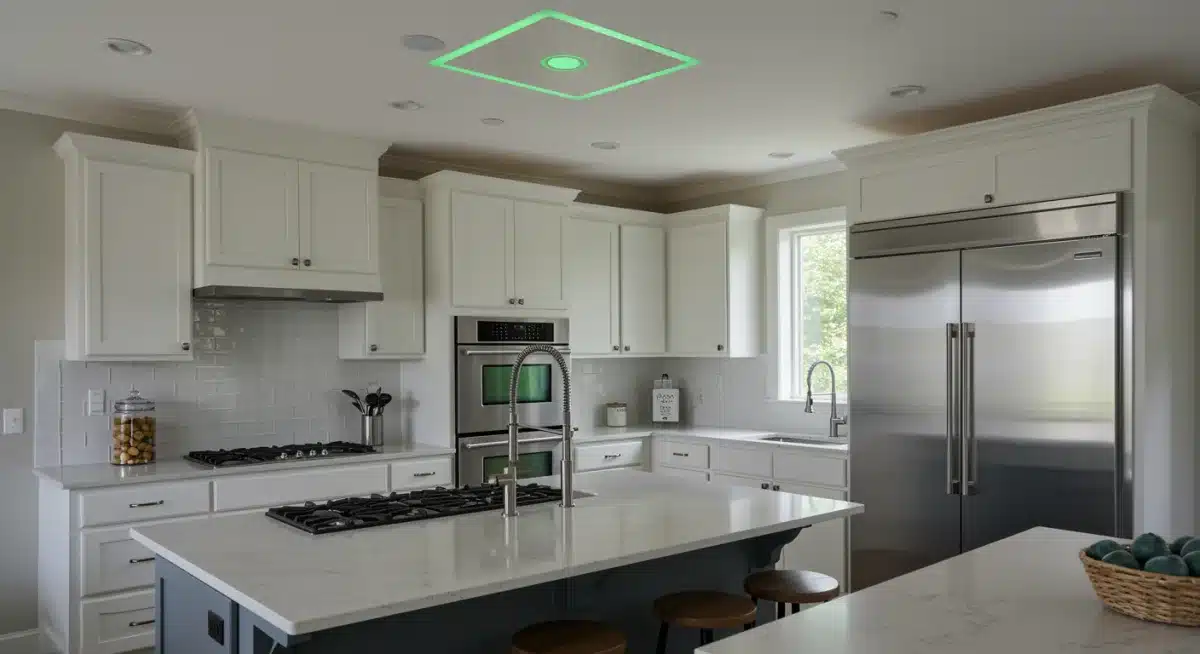
Optimized Resource Management
Smart sensors are now managing energy and water usage with unprecedented detail. This allows homeowners to identify and rectify inefficiencies, leading to significant savings and a reduced carbon footprint.
- Zoned HVAC Control: Sensors in each room ensure heating or cooling is only delivered where and when it’s needed, preventing energy waste in unoccupied areas.
- Smart Water Leak Detection: Early detection of leaks not only prevents costly damage but also conserves water by alerting homeowners to continuous drips or bursts.
- Appliance Load Balancing: Integrating with smart grids to run high-energy appliances during off-peak hours, optimizing energy consumption and potentially lowering utility bills.
Health and Wellness Monitoring in the Smart Home
The integration of health and wellness monitoring into smart home sensor systems is a growing trend, offering residents unprecedented insights into their living environment’s impact on their well-being. These sensors go beyond basic comfort, actively contributing to a healthier lifestyle.
From air quality to sleep patterns, the smart home of 2025 is becoming a proactive partner in maintaining resident health, providing actionable data and automated adjustments.
Environmental Health Indicators
Sensors are now capable of monitoring a wide range of environmental factors that directly affect health, providing real-time data and automated interventions.
- Indoor Air Quality (IAQ): Detection of volatile organic compounds (VOCs), particulate matter (PM2.5), carbon monoxide, and radon, with alerts and automatic ventilation.
- Circadian Lighting: Adjusting light intensity and color temperature throughout the day to align with natural circadian rhythms, improving sleep quality and overall mood.
- Noise Pollution Monitoring: Identifying excessive noise levels and suggesting solutions or automatically activating sound-masking systems for improved tranquility.
Seamless Integration and Interoperability
A major hurdle in previous smart home generations was the lack of seamless integration between devices from different manufacturers. In 2025, interoperability is a core focus, driven by new industry standards and open protocols.
This means homeowners can now build comprehensive smart home ecosystems without being locked into a single brand, fostering greater flexibility and choice. The user experience is significantly enhanced as all devices communicate and cooperate effortlessly.
Unified Control Platforms
The emergence of unified control platforms and standardized communication protocols is simplifying the management of diverse smart home devices. This allows a single app or voice assistant to control all aspects of the smart home, regardless of brand.
- Matter and Thread Adoption: Widespread adoption of open standards like Matter and Thread ensures cross-device compatibility and easier setup.
- Centralized Hubs: Advanced smart home hubs now act as universal translators, allowing devices using different protocols to communicate seamlessly.
- API Integrations: Manufacturers are increasingly opening up their APIs (Application Programming Interfaces), enabling third-party developers to create innovative integrations and services.
The Future of Smart Sensors: Proactive and Invisible
Looking ahead, the trajectory for Smart Home Sensors 2025 and beyond points towards even greater sophistication and invisibility. The goal is to create environments that are intuitively responsive, anticipating needs without explicit commands, and blending seamlessly into the home’s aesthetics.
Research and development are focused on self-powered sensors, nanotechnology, and even more advanced AI that can learn from subtle cues, further blurring the line between technology and natural living.
Self-Sustaining Sensor Networks
The next frontier involves sensors that require minimal, if any, external power sources. This will simplify installation, reduce maintenance, and further integrate these devices into the very fabric of our homes.
- Energy Harvesting: Sensors powered by ambient light, kinetic energy, or even thermal differences, making them truly wireless and self-sufficient.
- Miniaturization: Continued reduction in sensor size, allowing for discreet placement within materials, paints, or even fabrics, making them virtually invisible.
- Edge AI Expansion: More processing power at the device level, reducing reliance on cloud computing and enhancing privacy and response times.
| Key Innovation | Brief Description |
|---|---|
| AI-Powered Prediction | Sensors now predict events and user needs, moving beyond reactive automation to proactive home management. |
| Hyper-Personalization | Systems adapt to individual preferences and environmental context for tailored living experiences. |
| Enhanced Security | Biometric access and advanced anomaly detection provide superior property protection. |
| Seamless Interoperability | New standards like Matter ensure devices from different brands work together effortlessly. |
Frequently Asked Questions About Smart Home Sensors in 2025
The most significant advancements in 2025 include AI-powered predictive capabilities, leading to proactive home management. This involves sensors learning routines to anticipate needs, detect anomalies, and offer predictive maintenance, moving beyond simple reactive automation for US properties.
New sensors enhance security through advanced anomaly detection, distinguishing normal activity from threats. They also integrate biometric authentication like facial recognition for access control and provide real-time identity verification, significantly reducing false alarms and improving overall property protection.
Yes, smart home sensors are crucial for energy savings. They enable zoned HVAC control, ensuring heating/cooling only where needed, and provide smart water leak detection to prevent waste. Additionally, they can balance appliance loads to optimize energy consumption during off-peak hours.
Hyper-personalization means smart homes adapt to individual preferences and environmental context. Sensors gather data on light, temperature, occupancy, and more to create dynamic lighting, optimized air quality, and personalized comfort zones, tailoring the living space to each resident’s unique needs and moods.
Yes, interoperability is a major focus in 2025. Widespread adoption of open standards like Matter and Thread, along with improved centralized hubs, ensures that devices from various manufacturers can communicate and work together seamlessly, simplifying setup and control for homeowners.
Looking Ahead
The current trajectory for Smart Home Sensors 2025 indicates a future where intelligent environments are not just a luxury but a standard. As AI advances and interoperability becomes universal, homeowners can anticipate even more intuitive, energy-efficient, and secure properties. The focus will continue to be on seamless integration, predictive capabilities, and a personalized living experience that adapts to individual needs without conscious effort. Keep an eye on ongoing developments in self-powered sensors and embedded nanotechnology, which promise to make these technologies virtually invisible yet profoundly impactful in the years to come.
